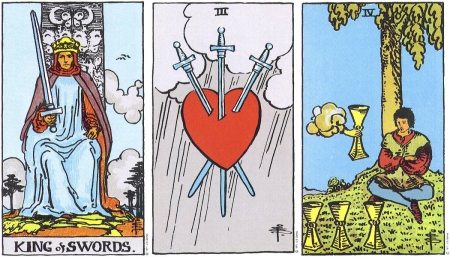By Sarah Taylor
Following on from last week’s reading, we have the Three of Swords at centre once more. This time, though, the context is different and so the energy is different. It is as if a layer has been peeled away, and this layer lies underneath — the next story to be told, the next transmutational focus.
There is still a second Swords card, but here, instead of the Eight of Swords, we have the King of Swords. He is the mature human, masculine embodiment of Ace energy. The historical figure I return to time and again with the King of Swords is that of Solomon: discernment, truth, wise compassion.
The King’s posture is upright, but at ease in spite of the heft of the blade. It can be used for battle, yes. The King, as Solomon, knows when that time is called for. That he is holding the sword in the hand that is further from the Three, and that the blade is slanted away from it, suggests that this is not the time to focus on a battle over emotional real estate — which is really a battle over something which can be wounded, but not owned: love.
Behind the King, the back of his throne depicts butterflies as symbols of transformation, crescent moons which bring a sense of the feminine as well as the cycles of nature, and figures that might be angelic or human. All of these stand in contrast to the hardness of the stone from which they are carved and the set of the King’s jaw — while his eyes remain soft. This feels like an exhortation to find the balance inherent in the beliefs we hold, and the actions we take based on them.

King of Swords, Three of Swords, Four of Cups from the Rider-Waite Smith Tarot deck, created by A E Waite and illustrated by Pamela Colman Smith. Click on the image for a larger version.
Truth is an action as well as a concept. The King knows when to act with the blade’s edge, and when to use it as a means to see and to understand. What the King of Swords knows is that this understanding can only start with the self. He is the human manifestation of the journey of the swords through its suit; he has experienced everything and come out wiser than he went in.
Unlike in the Three of Swords, which are embedded blade-down in the heart of a heart, all three blades vying for a piece of the flesh, the King holds his sword up in front of him, in the air to which it belongs. His action seems to work to oppose the energy of the Three, his look to us saying:
“This is how to wield a sword — with authority, with a light touch, working together with what it has to offer. It is the blade of insight.”
In the Three of Swords, the insight is lost to conflict.
As with the reading from last week, we have an association with the three swords at centre and three other objects in the final card — this time, three cups. Cups precede swords in the tarot, and from this is implied the un-layering that I referred to earlier. We are no longer in the realm of wounding thoughts and the self-imposed psychological barriers that we build around us. We are in heart territory, land of emotions and the unconscious. In this, it seems, we are getting closer to our depths, a place where we are more open to receive something different.
In the Four of Cups, we have the three cups on the ground in front of the youthful figure, who sits under a tree. He, like the woman in the Eight of Swords, is closed off. This closing off nevertheless is softer. He is not blindfolded, but rather his eyes are cast down. He is not encircled by swords, but rather by his own arms and legs. The puddled barrenness of an empty landscape is now green, the sky blue.
But he is still not seeing the whole picture.
What he’s not seeing is the the fourth cup, which closely resembles the Ace of Cups, carried in as it is by a hand emanating from a cloud. There it is in front of him, offering itself to him. The Ace embodies the energy of its suit as pure potential; it is love as an expression of the divine, without bounds or condition.
As beings limited to form and living in a world of contrast and contradiction, we are not able to contain the Ace fully. But we can choose to express it in the highest form available to us. And in the Four of Cups it is there for us to draw from if we can hold it in awareness. It can free us from the fetters that we find in the Three of Swords; the King as guardian of our thoughts is demonstrating this, by finding a different way of working with them.
To paraphrase a quote from A Course in Miracles, when we can remove the blocks to the awareness of love’s presence — in spite of every sensation of fear or disillusionment that wants to tell us a different story — we can move towards something closer to the truth in our hearts.
Astrology/Elemental correspondences: King of Swords (the fiery aspect of air), Three of Swords (Saturn in Libra), Four of Cups (Moon in Cancer)
If you want to experiment with tarot cards and don’t have any, we provide a free tarot spread generator using the Celtic Wings spread, which is based on the traditional Celtic Cross spread. This article explains how to use the spread.

